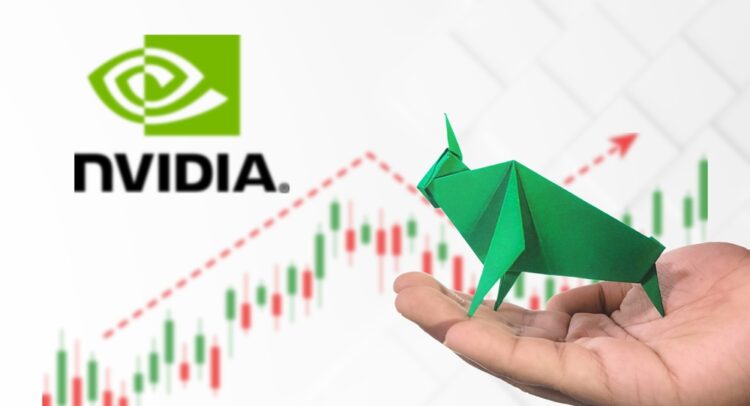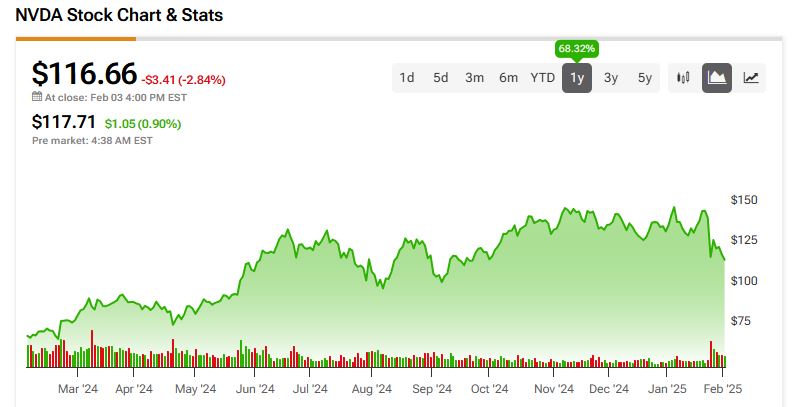Despite China’s DeepSeek model disrupting the broader artificial intelligence ecosystem, Nvidia (NVDA) remains the underlying hardware king. Therefore, the red ink imposed on NVDA stock would appear to be a discounted opportunity — an opinion shared by top analysts and investors. So, the argument isn’t about whether NVDA is an exciting bullish opportunity. Rather, the question is how best to capitalize on NVDA.
On a fundamental level, questions exist about the supposed ultra-low-cost nature of the DeepSeek algorithm. Further, the idea that China is about to launch an AI paradigm shift could be misleading. Major enterprises like Microsoft (MSFT) and Meta Platforms (META) are supply-constrained regarding their AI hardware needs. According to reports, they want to significantly expand their capital expenditures to boost their machine-intelligence capabilities.
The average price target of Wall Street analysts is $180 per share, which suggests around 54% upside to come. However, bullish investors can harness a particular options strategy to replicate big payouts over weeks, not years.
I’m bullish on a rebound in NVDA stock and continue to believe it will deliver strong returns for shareholders. However, there is a cleaner way of gaining exposure to the tech/AI theme and NVDA stock while generating even more substantial returns than traditional stock investing.
Understanding the Statistical Context Behind NVDA Stock
The first order of business is to recognize the short-term nature of options trading. Unlike the underlying security, options are classified as “wasting assets” because they all eventually expire worthless. Therefore, if you wager on so-called cheap options — or options far out the money — you effectively engage in binary transactions: you are either winning or losing.
Moreover, the progression of time exponentially reduces the option’s premium value as it nears expiration, which tends to mean options traders think short-term. Therefore, focusing on optionable securities like NVDA isn’t about broader fundamentals but pricing behaviors based on statistical trends.
Primarily, the key element that makes NVDA stock attractive to options traders is its upward bias. Statistically, when considering data over the trailing five years, traders who enter a position at the beginning of the week have a 56.98% chance of being profitable by the end of it. Over four weeks, the long odds improve to just over 66%.
In other words, outside of a truly compelling reason to be contrarian, the numbers favor taking a shot on NVDA stock.
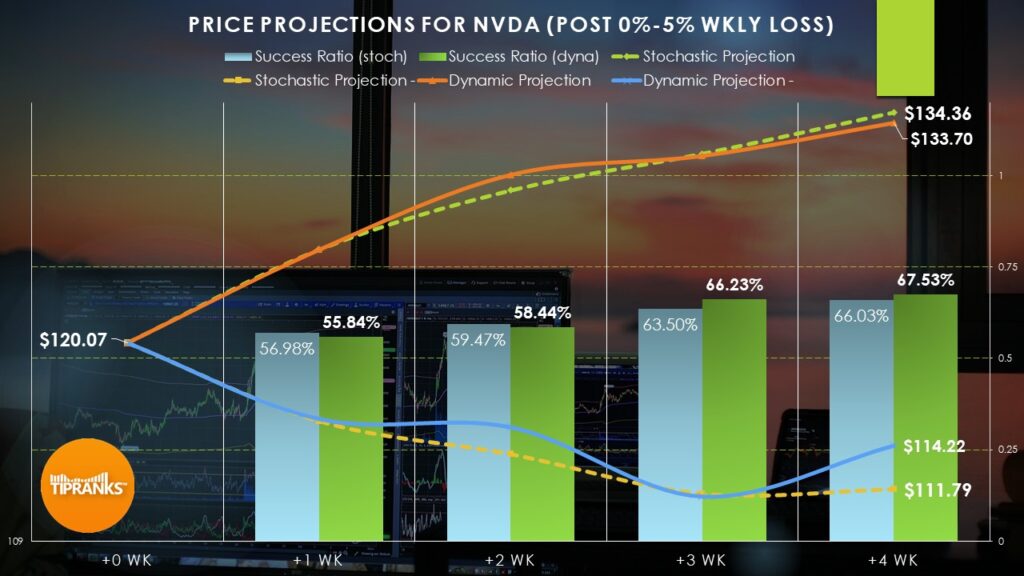
However, the market operates with human emotions, and responses can vary depending on fluctuations in the fear-greed continuum. Last week, NVDA stock incurred a loss of 3.79%. Whenever NVDA loses up to 5% of value over one week, there’s a 67.53% chance that the equity will have landed in positive territory by the end of the fourth subsequent week.
Stated differently, there’s evidence that investors tend to buy the dip during sizable declines (for the record, negative weeks over the past five years in NVDA carry a median loss of 3.7%). This framework provides all the more evidence that speculators are justified in wanting to buy Nvidia at a discount.
Options Traders Smell Blood
Viewing Nvidia stock pricing data in no other context aside from the temporal — NVDA may reach $134.36 over the next four weeks, assuming the positive scenario materializes. If the negative scenario occurs, there is a statistical risk that NVDA could fall to $111.79, according to the options chain expiring Feb. 28. From a dynamic perspective, NVDA is on pace to hit $133.70 per share in an optimistic scenario or fall to $111.79 in an adverse scenario. With this market intelligence, investors can execute a bullish options strategy called the bull call spread.
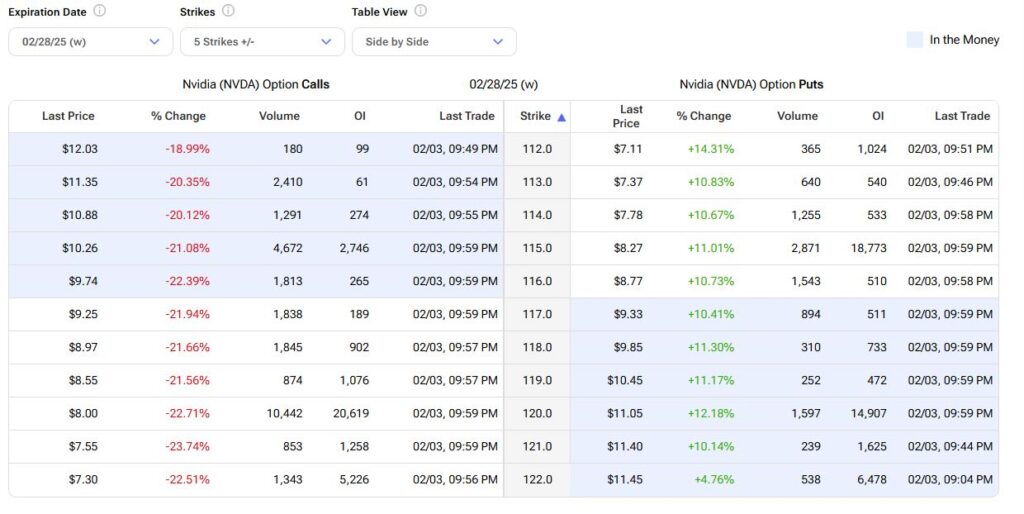
Under a bull spread, the trader buys a call option and simultaneously sells a call at a higher strike price (for the same expiration date). The idea is to use the credit received from the short call to partially offset the debit paid for the long call.
To be sure, the sale of the short call necessarily caps the reward at the representative strike price. However, the benefit is that the net cash outlay to enter the bullish position is discounted. Further, this discounting lowers the threshold to breakeven, improving the speculator’s odds of success compared to a call-only acquisition.
Now, the beauty of the bull spread comes in the form of the reward. If NVDA stock reaches $134, that’s a decent 11.6% return. However, if you only wager a thousand dollars on NVDA, the nominal reward would be $116. In contrast, the bull spread can offer far better rewards, depending on the specific transaction.
Options Allow Ideal Blend of Risk and Reward
One of the reasons why investors tend to shy away from multi-leg options strategies like the bull call spread is due to the plethora of available spreads. How does one know which spread to pick?
Let me tell you a little secret: it’s just like soccer.
In the beautiful game, you improve your scoring chances by committing more players to the attack. At the same time, you leave yourself vulnerable to a counterattack. If you’re worried about conceding a goal, you can take speculative long shots without committing too many players to the attack, although the chances of success are low.
In the options arena, the 111/134 bull call spread (buy the $111 call, sell the $134 call) for the options chain expiring Feb. 28 would be an example of a high-commitment attack. As of Monday’s close, the net debit required stood at $895 for the chance to earn $1,405 (a payout of 156.98%).
So long as NVDA stock doesn’t drop below $111 by Feb. 28, traders may be able to salvage some intrinsic value out of the long call. However, if Nvidia implodes (i.e., the market’s devastating counterattack), the trader will lose the entire net debit paid to enter the trade.
On the other hand, you can select the 132/134 bull spread. This trade only requires a $60 cash outlay for the chance to earn $140, or a payout of 233.33%. However, NVDA stock must reach $134 just to break even. Since both the long and short calls are well out of the money, there’s a strong chance you will lose the entire net debit paid.
Still, it may be worthwhile to take that potshot because NVDA stock has such a strong upward bias.
Is NVDA a Strong Buy?
Turning to Wall Street, NVDA stock has a Strong Buy consensus rating based on 37 Buy, three Hold, and zero Sell ratings. The average NVDA price target is $179.81 per share, implying a 54.13% upside potential. Currently, NVDA may just be the most Buy-rated stock in the U.S.
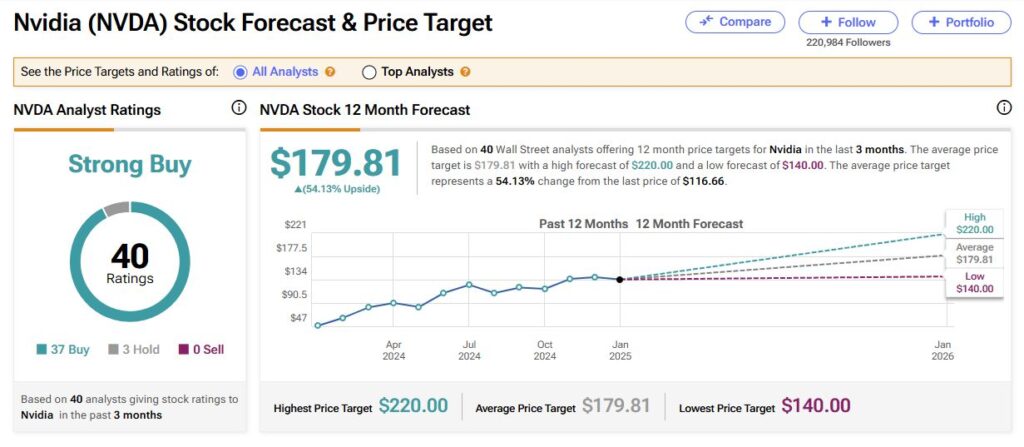

Optional Method of Gaining Exposure to Bullish NVDA Stock
NVDA stock took a hit last week due to concerns over China’s DeepSeek AI model, but the selloff could be an opportunity in disguise. Despite the noise, NVDA remains the dominant tech hardware player, and history suggests investors tend to buy the dip. The numbers support a bullish outlook, with statistical trends pointing to a likely rebound in the coming weeks.
Rather than simply following Wall St guidance and buying stock outright, options traders can take advantage of NVDA’s upside potential through a bull call spread. This approach leverages the stock’s upward bias while limiting risk. Depending on the chosen strike prices, traders can position themselves for a substantial payout if NVDA trades higher. Ultimately, it’s about structuring the trade like a calculated offensive play—balancing risk and reward based on market probabilities.
Questions or Comments about the article? Write to editor@tipranks.com
















